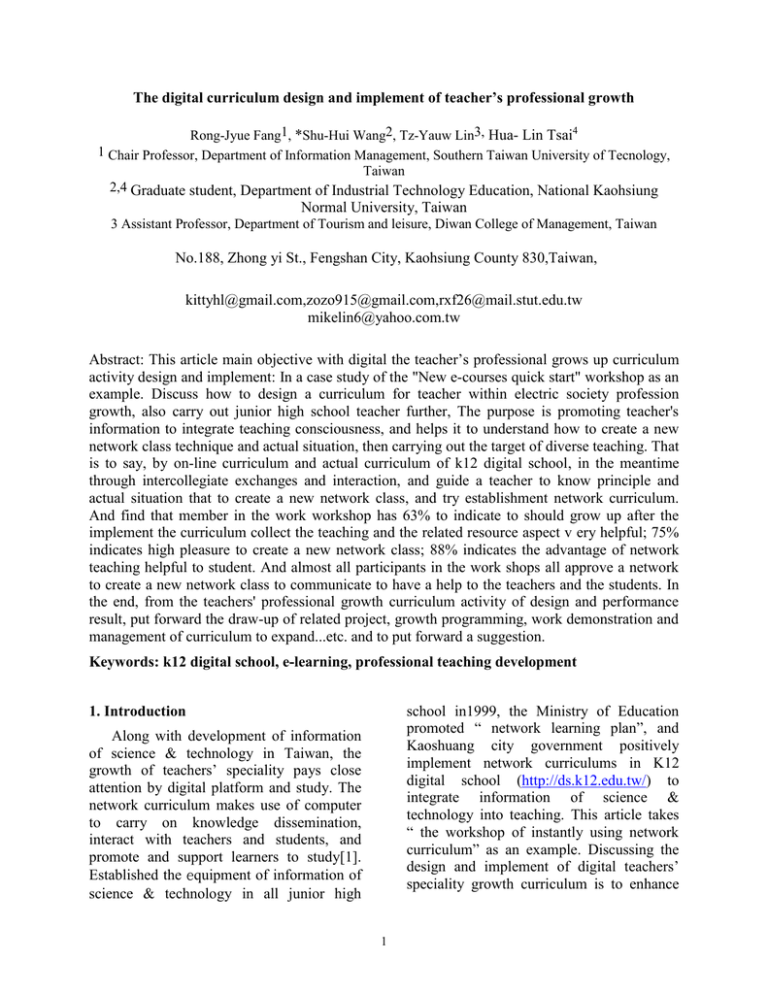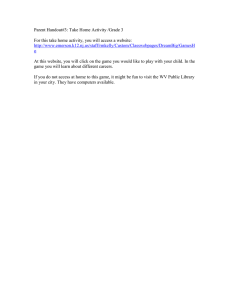The digital curriculum design and implement of teacher’s professional growth *
advertisement

The digital curriculum design and implement of teacher’s professional growth Rong-Jyue Fang1, *Shu-Hui Wang2, Tz-Yauw Lin3, Hua- Lin Tsai4 1 Chair Professor, Department of Information Management, Southern Taiwan University of Tecnology, Taiwan 2,4 Graduate student, Department of Industrial Technology Education, National Kaohsiung Normal University, Taiwan 3 Assistant Professor, Department of Tourism and leisure, Diwan College of Management, Taiwan No.188, Zhong yi St., Fengshan City, Kaohsiung County 830,Taiwan, kittyhl@gmail.com,zozo915@gmail.com,rxf26@mail.stut.edu.tw mikelin6@yahoo.com.tw Abstract: This article main objective with digital the teacher’s professional grows up curriculum activity design and implement: In a case study of the "New e-courses quick start" workshop as an example. Discuss how to design a curriculum for teacher within electric society profession growth, also carry out junior high school teacher further, The purpose is promoting teacher's information to integrate teaching consciousness, and helps it to understand how to create a new network class technique and actual situation, then carrying out the target of diverse teaching. That is to say, by on-line curriculum and actual curriculum of k12 digital school, in the meantime through intercollegiate exchanges and interaction, and guide a teacher to know principle and actual situation that to create a new network class, and try establishment network curriculum. And find that member in the work workshop has 63% to indicate to should grow up after the implement the curriculum collect the teaching and the related resource aspect v ery helpful; 75% indicates high pleasure to create a new network class; 88% indicates the advantage of network teaching helpful to student. And almost all participants in the work shops all approve a network to create a new network class to communicate to have a help to the teachers and the students. In the end, from the teachers' professional growth curriculum activity of design and performance result, put forward the draw-up of related project, growth programming, work demonstration and management of curriculum to expand...etc. and to put forward a suggestion. Keywords: k12 digital school, e-learning, professional teaching development school in1999, the Ministry of Education promoted “ network learning plan”, and Kaoshuang city government positively implement network curriculums in K12 digital school (http://ds.k12.edu.tw/) to integrate information of science & technology into teaching. This article takes “ the workshop of instantly using network curriculum” as an example. Discussing the design and implement of digital teachers’ speciality growth curriculum is to enhance 1. Introduction Along with development of information of science & technology in Taiwan, the growth of teachers’ speciality pays close attention by digital platform and study. The network curriculum makes use of computer to carry on knowledge dissemination, interact with teachers and students, and promote and support learners to study[1]. Established the equipment of information of science & technology in all junior high 1 teachers to integrate teaching knowledge and skills of network curriculum. It is to reach the goal of multiple teaching[2]. We will mainly discuss the following questions : common construction and so on, to enhance the effect of teachers’ preparatory work. Moreover, teachers store curriculums in K12, not only being convenient for teachers to adjust, renew and increase the curriculums, but also promoting the teachers’ peers to share teaching experience, and helping teachers to carry on follow-up teaching examination and action studies. 1.1 Do the network curriculum help collect the teaching resources? 1.2 Do the teachers agree with the network curriculum? 1.3 What do the teachers think about the utilization of the network curriculum? The network curriculum can record the process of students’ learning and effects. For example, K12 can record the materials’ pages, the time, the times, and the articles which students participate in a discussion on the network, and can provide simultaneously a lot of functions, such as handing in homework, taking a tests, as well as statistics analysis of school report card of all class and so on. The digital notebook can also let students record the articles that one has learned from work, study, etc., or the related things. Moreover[3,8,9], K12 can provide a lot of records, such as students’ personal information, the process of learning, the results of tests, as well as assignments and so on. K12 advises the related messages by E-mail, and can help teachers or students’ parents view students’ learning conditions. The contents of subjects discussed on the network will automatically send out by teachers who set this system. The discussed contents will synchronously be sent to each student, and the school report cards of the tests and assignment will also be sent to students or students’ parents. Therefore, students’ parents can grasp students’ learning conditions by about-mentioned way, and keep in touch with teachers by E-mail to help communicate and interact between teachers, students and students’ parents. 1.4 Does the network curriculum help the teachers communicate with the students? 2. Advantages of the network curriculum integrated into teaching That the equipment of information network is popular is one of advantages of the network curriculum integrated into teaching. Besides, another advantage is that the junior high school students know how to operate computer with the basic operation ability. Many scholars think that the network curriculums have rich teaching resources, the learning environment of providing interaction and personalization, as well as unrestricted time and space and so on [4]. In addition, the content of curriculum transfers to digital teaching materials with the effect of sound and light to help initiate students’ learning interest. However, the teaching platform provided by K12 not only lets teachers establish the storehouse of teaching materials and tests which teachers can instantly give students feedback, but also teachers can adjust the process of learning to fit the various differences of students. The network provides teachers to seek for the teaching resources and materials, and the network curriculums also provide teachers to schematize and establish the space of the teaching information. mentioned that the digital technology in editing the teaching materials has the many advantages, such as instant edit, various mass media integration, as well as On another aspect, about the present situation of making use of the network curriculums to carry on the teaching for junior high school teachers, [5,8,9] discovered that the elementary school and junior high school teachers can accept the 2 new knowledge of computer technology, but seldom integrate network technology into teaching after network training. Besides, aimed at the questionnaire of network anxious phenomenon for junior high school teachers discovered that the network anxious phenomenon shows high index when teachers have inexperience in using network or seldom using network[7]. Thus, it is worth to pay attention to an important subject that how to help and guide teachers to understand and use information to integrate into teaching. According to the view at present US integrates network technology into the study domain, and coheres experts, teachers and students lived scattered in each place to be a fictitious social group by network pointed out that the effective advanced study in long distance can encourage teachers to participate in the design of advanced study activities and pay attention to feedback of teaching. using the network technology, a teacher never used computer, and the computer in the classroom never opened, but now he or she usually uses a computer as a teaching tool. Thus, aimed at the growth activity of information integrated teaching, it will affect teachers to make use of the information network to carry on the teaching. 3. Curriculum design and implementation in the workshop This teacher growth curriculum mainly is formed by the workshop, and the subject is " instantly use network curriculum ". The contents of this curriculum are established in the platform of K12 digotal school in Kaoshuang. This curriculum takes eighteen hours to teach, and the implementation methods include face to face teaching, interaction on the network, actually carring on editing digital teaching materials, and network class. Therefore, the workshop guides teachers to understand and try to the preliminary curriculum that carries on the network class. The workshop encourages the members to participate this curriculum. It has forty-two members to join until now. The implementation method is mainly to guide teachers to know the idea and business of the network class by actual curriculum and interaction on the network, and to try to establish the network curriculums. Based on the above mention, making use of the on-line workshop provides teachers to contact the network curriculums, studies how to schematize and manage the network curriculums, and cultivates the ability of network class[10]. At the same time, it should remind teachers to notice the teaching application in network when they make use of the network technology. Participated the network class, teachers have to own the ability of planning the network teaching activity, doing assignment, managing the network classes, using the network technology integrated into teaching and assisting teaching. That how to assist teachers in possessing above-mentioned abilities is waiting for study. The contents of the workshop include “ network assists teaching”, “how to apply K12 network class”, “know the environment of K12 network class”, “decide the subject of network class and prepare the teaching materials”, “establish skills of the network curriculum”, “manage the business of the network curriculum”, “actually apply personal network curriculum”, “establish the database of personal teaching materials” and Took the network in California, USA, as an example[1,3,4], indicated that the successful factors are the support of units which make a strategic decision, coordination with district conditions, improved and perfect projects. For example, before participating the teaching project of 3 so on, and edit “ the handbook of K12 network class”. 4. Implementation analysis result and interaction and teaching with teachers, students, and students’ parents, it will not only cultivate students to use the ability of information technology, but also guide them to use the network resources correctly. The curriculums in the workshop by helping teachers carry on the network class provide the related suggestions, such as the draft of the related project, the plan of the growth curriculum, result display, management popularization, and carrying on the network curriculum and so on, to consult. data Except discussing the related reference this curriculum is to carry on data analysis of the workshop operation, the condition of members’ participation. Making use of the function of questionnaire in K12 designs on-line questionnaires for members of the workshop to answer freely. The results of the questionnaires mainly adopt descriptive statistics to carry on data analysis, and discover that 63% of members of the workshop indicate this growth curriculum to the collection aspect of teaching and related resources has more helping; 75% of members have high willingness to the network class; 88% of members indicate that using the network teaching helps students. Almost all participants approve that the network class helps teachers communicate with students. 5.1 The aspect of the draft of project : The suggestion is to seek for the related units like the Ministry of Education to execute project. For example, the Ministry of Education provides all schools to apply the teaching plan integrated by the information of teachers’ expert social group every year. Thus, it will not only have the financial subsidy to buy the equipment of information soflectiont & hardware , but also provide the opportunity for teachers to advance the growth and share experience. Moreover, carrying on observation by the participation of members of the workshop and the condition of network interaction includes uploading questions, suggestion, handing in assignment, on-line discussion and so on. 5.2 The aspect of planning the curriculum : The suggestion is to carry on by the type of productive or professional workshop. The design can be applied instantly in the content of activity of teaching scene. It should pay attention to the sharing of teaching business and interaction between teachers’ peers or schools. Therefore, it accords with the actual teaching need for teachers. 5. Conclusion The network provides the platform of sharing knowledge and exchange. The network curriculum has many advantages, such as richer teaching resources, providing interaction, personalization, digital teaching materials with the effect of sound and light and unrestricted time and space and so on. At present, students acquire knowledge from other place and no longer from the classroom. If teachers can utilize global information network and educational technology well, and construct a meaningful learning environment by network to carry on 5.3 The aspect of result display : The suggestion is to carry on by homepages or on-line curriculums. Implementing results of digital content systematically established can provide teachers to surf the network to research information or to use the related contents for long time. 5.4 4 The aspect of management popularization : The suggestion is to make use of seed teachers or growing little groups to encourage teachers to participate in management popularization. With the experience of the network class or better information ability, teachers carry on teaching the experience. Thus, it can establish the learning type organization among schools, and reach the effect of popularization. Techonology Review.1996.Winter(5):26-30. [4]Liaw, S. S. (2004a). Considerations for developing constructivist Web-based learning. International Journal of Instructional Media, 31(3),309–321 [5]Wong, L. H., Quek, C., & Looi, C. K. (1998). TAP: a software architecture for an inquiry dialogue-based tutoring system. IEEE Transactions on Systems, Man and Cybernetics, Part A, 28(3), 315–325. 5.5 The aspect of carrying on the network curriculum : The suggestion is to plan preparatory works, including the computer classroom, the network equipment, the application of on-line curriculum, the application of address for students’ participation and so on. It also has to mention students to prepare personal E-mail address, and guide them how to change the personal code. Teachers have to be familiar with the operation skills of K12 interface, establish and choose the suitable teaching materials, collect the related network resources, and plan the content of the tests and so on. That students participate the plan of the network curriculums is emphasized. The illustration of “the discussion of subject” can help students to be skilful at the operation of the interfact , and avoid the unsuitable articles. [6]Yoshikawa, A., Shintani, M., & Ohba, Y. (2000). Intelligent tutoring system for electric circuit exercising. IEEE Transactions on Education, 35(3), 222–225.Zadeh, L. A. (1965). Fuzzy sets. Information and Cont, 8, 338–353. [7] R. J. Fang, H. J. Yang, C. C. Lin, H. H. Yang, and J. C. Yu, "A Comparison of Applying the Theory of Reasoned Action and the Theory of Planned Behavior on Predicting On-line KT Intention," WSEAS Transactions on Mathematics, vol. 6, pp. pp.432-438, 2007. [8] R. J. Fang, H. J. Yang, H. L. Tsai, C. J. Lee, and C. C. Lin, "Global d-Learning through Internet for grades 1-9 StudentsAviation Technology Education," WSEAS Transactions on Advances in Engineering Education, vol. 4, pp. pp.17-25, 2007. Reference [9] R. J. Fang, H. J. Yang, H. L. Tsai, C. J. Lee, and T. S. Tsai, "An International Culture Online Exchange Model of K-12 Students," WSEAS Transactions on Mathematics, vol. 6, pp. pp.426-431., 2007. [1]Antao, B. A. A., Brodersen, A. J., Bourne, J. R., & Cantwell, J. R. (2000). Building intelligent tutorial systems for teaching simulation in engineering education. IEEE Transactions on Education, 35(3), 222–225. [10] H. H. Yang, J. C. Yu, and H. J. Yang, "A Study of Statistical Software Acceptance Based upon TRA Model," WSEAS Transactions on Advances in Engineering Education, vol. 4, pp. pp.83-90, 2007 [2]Berge, Z. Characteristics of online teaching inpost-secondary. formal education. Educational Techonology.1997.37(3): 35-47. [3]Kearley, J. E. The World Wide Web: Global access toeducation. Educational 5

